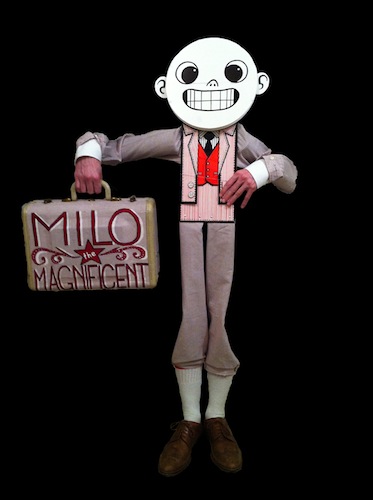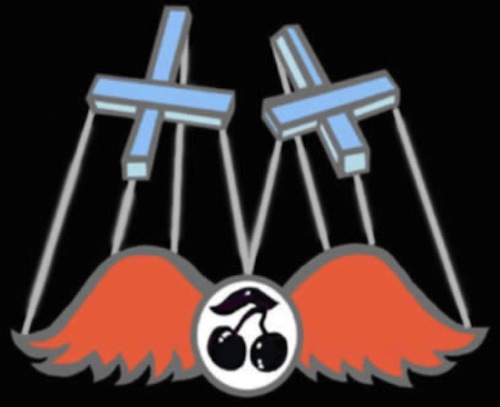In an unsuspecting corner of Hollins Market in Sowebo, behind an ordinary old white door, is a most magical place. On a Saturday evening earlier this month, at the latest Puppet Slamwich at Black Cherry Puppet Theater, I sat among twinkling lights, the aroma of popcorn, and a captivated, full house . I caught up with artists Alex Vernon and Sarah Olmsted Thomas to inquire about their unique character, Milo the Magnificent.
Jill: Milo is instantly lovable, the audience is immediately charmed by this humble, exuberant little man. Tell me more about Milo, where does he come from? What inspirations, imaginings, influences helped you create him? What do you love most about him?
Alex: I created Milo in the summer of 2011, while doing a tour of a Children’s Theater show in Singapore. The shows were only in the morning so I had a lot of free time to come up with new acts. I think Milo might be a heightened version of myself when I was 13. That’s when I really got into juggling and magic and inventing. Performing with Milo is sort of like giving kid-me a chance to perform in front of a crowd. I see a lot of puppets that are rude and in-your-face for shock value, but what I love most about Milo is that he’s totally genuine in whatever he does.
Sarah: Milo’s timidity and excitement are palpable from the moment he walks onstage. I think he is so likable because he is very sensitive to the presence of the crowd in the room. This can be attributed both to his versatile facial expressions and to Alex’s keen manipulation of his gestures.
Jill: Is he a character in this single performance, or will his character be involved in future narratives?
Alex & Sarah: Milo had his debut performance at the DC Clown Cabaret in 2011. This first act was totally different from the one we performed at Black Cherry Puppet Theater for the March Slamwich. It involved audience participation and a brief romance with a lady counterpart. We are planning on creating more pieces for him to perform.
Jill: One of the most endearing parts of Milo are his facial expressions which are quickly flipped to show a range of emotions. Can you describe how Milo’s face and body are constructed?
Alex: Milo has a 2d circular face made up of styrene (a thin, strong plastic) semicircles with facial features drawn on with Sharpie. They’re connected like pages of a book turned sideways. He has a total of 13 different expressions that he can flip between. His body is also made out of styrene sheets, built up in layers to give his clothes a bit of depth. His arms and legs are fabric that connect to my own hands and feet.
Jill: The plot of the performance seems secondary to the audience’s engagement with Milo. Can you describe the plot line, and what you hope to convey through the narrative?
Alex & Sarah: Yeah, the plot is pretty simple. Milo, an aspiring magician and inventor, demonstrates his talents in Magic and Science through a series of magic tricks and a new creation, “The Mechanical Man.” He presents the versatility of his robotic friend in a series of demonstrative feats. We were really trying to get the audience to connect with the characters and root for them.
Jill: Can you each tell a little about your individual artistic practices and how you came to collaborate? Have you worked on other projects together? Do you have plans to collaborate more in the future?
Sarah: I studied literature at Sarah Lawrence College and then trained more specifically in physical theater with the Pig Iron Theatre Company in Philadelphia and Le Samovar, Ecole de Clowns, in Paris. I also completed an apprenticeship with Bread and Puppet Theater in Glover, VT. These educational experiences have informed my work intrinsically, but there’s nothing like a live audience to decode the real essence of how to tell a story. In that respect, I still feel like a student in this work.
Alex: I studied theater at Eastern Connecticut State University and Middle Tennessee State University before moving up to the DC area. In between gigs, I would work as a set carpenter/painter for local theaters. We met doing a puppet show together, actually. Master Puppeteer Julia Tasheva taught us a lot about the finer techniques of puppetry on that show. We’ve done many shows together since then, and have created several pieces together. We’re also both company members with Happenstance Theater, which does only original, devised works. Also, we recently got engaged, so we’ll be collaborating for a while.
Jill: I’ve been to two puppet slams this year at Black Cherry, and sat among an enthusiastic, packed house. Tell me about the puppet scene in Baltimore. It seems like a blossoming medium. What appeals to you about puppetry?
Sarah: Puppetry’s historical presence in nearly every human society makes it profoundly accessible. It’s as if it’s a form of storytelling that is in our collective consciousness. You can imagine cavemen, long ago, sitting around a fire and manipulating rocks and brush as a means of communication. There is a primal quality to how clear this form of storytelling can be, and I relish it.
Alex: The puppet scene in Baltimore seems to be amazing. Valeska Populoh is doing amazing things with her Puppet Slam, and we were really pleasantly surprised with the great turnout. I love puppetry because people have an amazing ability to project their feelings on objects. When Kermit is sad we feel sad. I think it’s easier for people to let go and believe that a felt frog loves a felt pig than it is to watch two human actors on stage pretending to be in love.
Jill: What are your current projects? Anything else you’d like to share?
Alex & Sarah: We’re currently working on Vanitas with Happenstance Theater (March 19th – April 4th, Roundhouse Silver Spring, MD). It’s a piece inspired by the Age of Discovery and cabinets of curiosity.
Author: Jill Gordon is an urban explorer, fiber artist, and writer who is both enamored and bewildered by the grit and vitality found in her fair city. She is a member of Mother Made Baltimore. Jill Gordon walks to The D Center on cold winter evenings for kicks, and can be contacted at [email protected].









